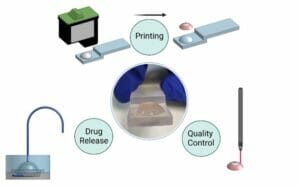- Home
- Drug loaded contact lenses using inkjet printing, with NIR spectroscopy quality control
- Drug loaded contact lenses using inkjet printing, with NIR spectroscopy quality control
The current treatment for a lot of ophthalmic diseases is to use eye drops. However, these aren’t great as they have low bioavailabilities and non-compliance. They are also incompatible with contact lenses, which need to be removed before administering the eye drops. For glaucoma, 9 out of 10 patients are not able to correctly administer eye drops (1), and so clearly there is the potential to improve. Further to this, there is a need for personalised medicine within ophthalmology (2), and especially at the point-of-care, as patients are often less mobile (3).
Point-of-care manufacturing of contact lenses could be a great solution but as of yet there is not a practical quality control (QC) method. QC is important in manufacturing for verifying that the drug dispensed is at the correct dose. Point-of-care manufacturing would require a QC method which is portable and non-destructive.
With these issues in mind, we wanted to evaluate whether inkjet printing drugs onto contact lenses is a viable method for delivering drugs to the eye, and whether near infra-red (NIR) spectroscopy can be used to verify the drug dose dispensed. We used Timolol maleate, a glaucoma drug, as the model drug in a 70/30 (v/v) solution of DMSO and water. Using this as the ink, we managed to demonstrate reliable loading of the contact lenses, and that light transmission through the contact lens was not affected by printing. Using a custom designed rig, we managed to demonstrate that the drug is fully released at some point between 3 and 7 hrs, much longer than the 10 minutes seen with eye drops (4). We also tested NIR spectroscopy as a QC measure, and found that the drug dose could be predicted with a strong linearity. Overall, the work we have done demonstrates the potential for personalised drug loaded contact lenses within inkjet printing, and that this can be verified with NIR as a QC measure.

You can check out our article here! https://doi.org/10.1016/j.ijpx.2022.100150
Ref:
1. Gupta R, Patil B, Shah BM, Bali SJ, Mishra SK, Dada T. Evaluating Eye Drop Instillation Technique in Glaucoma Patients. Journal of Glaucoma. 2012;21(3).
2. Ong FS, Kuo JZ, Wu W-C, Cheng C-Y, Blackwell W-LB, Taylor BL, et al. Personalized Medicine in Ophthalmology: From Pharmacogenetic Biomarkers to Therapeutic and Dosage Optimization. Journal of Personalized Medicine [Internet]. 2013; 3(1):[40-69 pp.].
3. Friedman DS, Freeman E, Munoz B, Jampel HD, West SK. Glaucoma and Mobility Performance: The Salisbury Eye Evaluation Project. Ophthalmology. 2007;114(12):2232-7.e1.
4. Jumelle C, Gholizadeh S, Annabi N, Dana R. Advances and limitations of drug delivery systems formulated as eye drops. Journal of Controlled Release. 2020;321:1-22.


